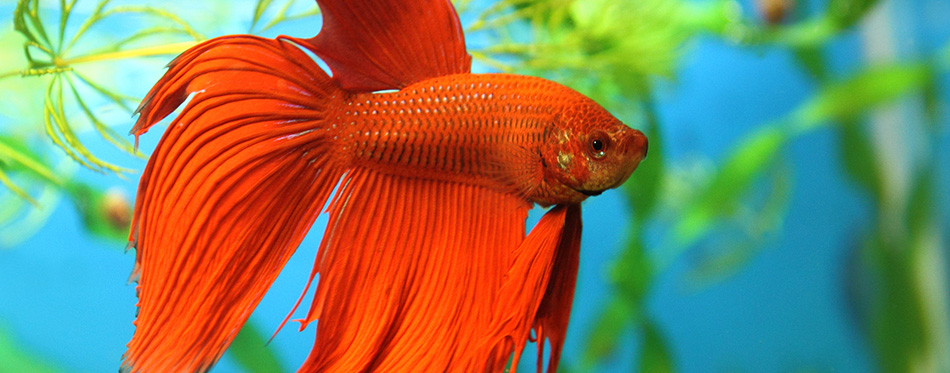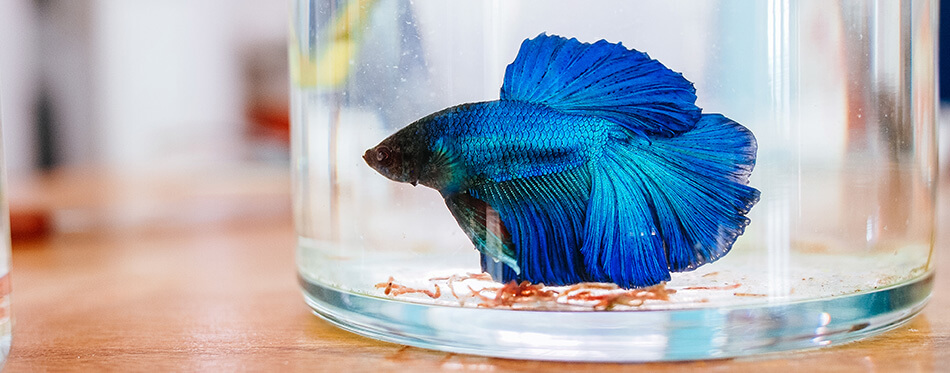Betta fish are a stunning choice for any budding aquarium enthusiast. Usually the first port of call for new fish owners, they are beautiful fish that are relatively easy to care for when compared to other aquarium fish. But many people ask why do betta fish fight? The more inexperienced betta owners commonly make a vital mistake when it comes to beta care that often results in injury or even death of one or more of them. Here’s why betta fish fight, and what you can do to avoid it.
What are Betta Fish?
Betta fish, also called Siamese Fighting Fish, are small exotic multicolored fish, native to Thailand. They have distinctive exceptionally long, flowing fins that give them a dramatic yet elegant appearance. They’re often chosen over other fish for their vivid colors and mesmerizing fins, though many people underestimate the character of a betta fish and assume it is docile like many other fish species.
Sadly, they also have a tragic history in their native Thailand of being kept for betta fish fights (much like dog fights). This use for betta fish is considered a severe breach of animal rights and is a strong concern for animal welfare activists.

Why Betta Fish Fight
The problem is most often seen when two male bettas are placed into a single tank together – it can even happen with a father and son. When one male betta is forced to be tank mates with another male, it can cause a territory issue, as betta fish are extremely territorial. This problem is often resolved by the two bettas aggressively fighting one another (more often than you might think they fight to the death).
Betta fish are naturally aggressive and incredibly territorial, therefore combining them with other betta fish is often a recipe for trouble, unless they are particularly well socialized or from a calmer breed. They will fight over a wide range of things including:
- Territory
- Food resources
- Hiding places
- Females
- To protect their eggs or young
- To defend their bubble nest
- Out of stress
- As a startle reflex
- Due to changes in the environment
- Being unsettled by new aquarium decorations in the tank
- To establish roles
- When they feel threatened by other larger, brighter, longer-finned fish
- When a fish looks like another betta fish
As we said, they’re naturally aggressive and so they will fight over just about anything. As a result, most betta owners will not own more than one at a time, and they will definitely not bring a female into a tank with two males unless it is mating season, after which they will remove the female immediately. This is particularly true with the most popular breed of betta – betta splendens.
How To Recognise Betta Fish Fighting
There are three major signs of fighting betta fish: gill flaring, fin nipping, or ramming. One fish will usually start with gill flaring as a show of dominance in an attempt to intimidate the one they are feeling aggressive towards. This is the first port of call before making physical contact.
Bettas look their most spectacular when they are flaring as they are raising their long fins to appear large – though it is a stunning sight, it is not good and you should try to defuse the situation as quickly as possible to prevent injury.
What if I Don’t See them Fighting?
There are other ways to recognize betta aggression. If you don’t see them actively fighting one another there are other signs of a betta fight including damaged fins, missing scales, and a longer hiding period.
Furthermore, there are additional signs of fight damage that mean you should consider placing your bettas in separate tanks such as decreased appetite, disappearance from view, lethargy, or if a fish suddenly dies whilst unsupervised with a betta. They may be known as siamese fighting fish, but that doesn’t mean you shouldn’t try to stop when bettas fight for the food of the tank community.
How To Prevent Betta Fish Fighting
If you decided to have more than one betta as pet fish, they should be kept in separate aquariums – especially if they are both male bettas. It is often heard that betta fish kill one another when under pressure or feeling particularly stressed. Therefore you should work to elevate that anxiety by separating the fighting fish and allowing them to have their own space. Outside giving your beta fish its own tank, there are several other things you can do to reduce the possibility of betta fights:
- Remove or cover all mirrored surfaces (for bettas these “enrichment items” can be highly stressful)
- Aggression reduction therapy with Prozac or Marijuana (first speak with your vet)
- If the aggression is particularly severe you may have to remove it from all other fish
- Provide plenty of hiding space to encourage a feeling of safety and security
- Do not introduce other fish to the tank, as betta fish fighting is not exclusively aimed at other bettas
The Consequences of Captivity
There is currently a debate as to how much betta fish fight depending on the method through which they were reared in captivity. There are some studies that suggest betta fish are partially influenced by their surroundings, meaning bettas raised in groups showed less aggressive behavior than those raised in isolation.
Unfortunately, most breeders don’t divulge information on how the bettas were reared, and you may find that you will simply have to put your betta into the fish tank and monitor its progress for signs of aggression towards others.
The Right Fish Tank for Betta Fish
It is recommended that a beta fish’s tank replicate its natural habitat as much as possible in order to reduce stress and therefore reduce the likelihood of aggression. Most betta fish tanks are larger than you might expect with plenty of hiding spaces.
Smaller fish tanks can make a betta feel trapped, especially if it has been placed in a small tank with another brightly colored fish that could make it feel threatened.
Mixing Bettas With Other Species
Keeping fish (particularly docile species of fish) with one or more betta can be troublesome if you’ve selected the wrong fish for the job. However, it is possible for some betta fish to make good tank mates so long as the conditions are right and you’ve combined the correct fish in the community.
Additionally, betas should be added to the tank last so that they don’t become territorial towards newcomers. A single female betta fish often does well in a community tank with other non-aggressive fish species. When selecting tank mates for a betta you should consider the following species:
- Harlequin rasbora: Possibly the best tank mates for male Bettas. They inhabit the same waters as bettas in the wild.
- Neon tetras: They are a peaceful, shoaling species (small and takes up very little space)
- Pleco: A bottom-dwelling species
- Otocinclus catfish: Not a very active species and often remains at the bottom of the tank
- Short-fin molly: A peaceful and shoaling species
- Kuhli loach: Usually more active at night and help to keep the tank clean
- Diamond tetra: An active, hardy, social species
- Glowlight tetra: A peaceful, shoaling species. (grows to around 2-inches long)
- Celestial pearl danio: A small shoaling species
- Cory catfish: Bottom-dwelling community-friendly fish
- Endlers: A small shoaling species (grows to about 1-inch long)
- Silvertip tetra: An active and shoaling species (grows to just over 1-inch long)
- Platy (Short-finned): A social shoaling species
- White Cloud Mountain minnow: A robust social shoaling species
- Ember tetra: A calm-tempered, shoaling fish (small and takes up very little space)
- Glass catfish: See-through fish that don’t appear threatening (recommended for larger tanks)
- Celestial pearl danio: A small shoaling species
- Fire rasbora: A social and peaceful species (best kept in groups of 8+)

FAQs:
Q: Do female betta fish fight?
A: Yes. Though female bettas are less aggressive than their male counterparts, they do still fight as they are still part of the Siamese Fighting Fish breed. They also fight other fish, which means you should be very careful about what you select to be in the same aquarium as them. Two or more males should never be kept together.
Q: Do male betta fish fight?
A: Yes. Male betta fish are significantly more aggressive than their female counterpart, especially when it comes to having other males in the same tank. It is often a territorial response caused by a male feeling as though another male might be encroaching on its space or food. Aggression can also be heightened when two males become competitive over a female.
Q: Do male and female betta fish fight each other?
A: They can. However, what can often appear to be male and female betta fish fighting on the outside, may actually be a sign that the male is trying to court the female. Males will ordinarily flare-up in an effort to attract the attention of a female mate. Though it is also possible for male bettas to be aggressive towards female bettas in a community tank and so it’s not recommended to keep the two together outside of mating season.

